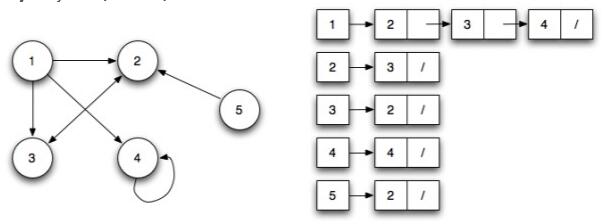数据结构与算法插入排序(Insertion Sort)冒泡排序(Bubble Sort)选择排序(Selection Sort)快速排序(Quick Sort)希尔排序(Shell Sort)归并排序(Merge Sort)堆排序(Heap Sort)计数排序(Counting Sort)桶排序(Bucket Sort)基数排序(Radix Sort)栈(Stack)队列(Queue)链表( Linked List)集合(Set)哈希表/散列表(Hash Table)树( Tree)_二叉树堆(Heap)字典树(Trie)图(Graph)
图(Graph)
概念和结构
- 图是由顶点和连接顶点的边构成的,通常将数据元素称为顶点,顶点之间的关系称为边。
- 图分为两种,一种是有向图,另一种是无向图。
- 图常用的表示方法有两种,一种是邻接矩阵,另一种是邻接表。因为邻接矩阵会占用更多的内存,而且进行添加和删除操作会很麻烦,所以这里我们实现邻接表。

Graph在实际生活中有很多用途,比如:导航软件计算最佳路径,社交软件进行好友推荐等等。
Graph通常有两种表达方式:
Adjaceny List(邻接列表):

邻接列表可以表示为左侧是节点的列表,右侧列出它所连接的所有其他节点。
和 Adjacency Matrix(邻接矩阵):

邻接矩阵用矩阵来表示节点之间的连接关系,每行或者每列表示一个节点,行和列的交叉处的数字表示节点之间的关系:0表示没用连接,1表示有连接,大于1表示不同的权重。
无向图的操作
无向图有六种常用操作,分别为添加顶点 addVertex(v)
添加边 addEdge(a,b)
打印邻接表 print()
广度优先遍历 bfs(v,callback)
获取最短路径 shortestPath(from,to)
深度优先遍历 dfs(v,callback)
JS实现无向图
JS里面的树结构需要通过对象(object)和数组(array)来实现,其中,对象用来存放边,数组用来存放顶点。var Graph = function(){
//存储顶点
var vertexes = [];
//存储边
var edges = {};
//添加顶点
this.addVertex = function(v){
if(!vertexes.includes(v)){
vertexes.push(v);
edges[v] = [];
}
}
//添加边
this.addEdge = function(a, b){
if(vertexes.includes(a) && vertexes.includes(b)){
if(!edges[a].includes(b)){
edges[a].push(b);
edges[b].push(a);
}
}
}
//打印邻接表
this.print = function(){
vertexes.forEach(element => {
var s = element + " => ";
edges[element].forEach(element2 => {
s += element2;
});
console.log(s);
});
}
//广度优先遍历
//用颜色标记状态 white -> 未探索 grey -> 已发现 black -> 已探索
this.bfs = function(v , callback){
//初始化颜色
var color = initColor();
//创建队列
var queue = new Queue();
queue.enqueue(v);
while(!queue.isEmpty()){
//正在遍历的顶点now
var now = queue.dequeue();
//遍历now相连的每个顶点
edges[now].forEach(element => {
if(color[element] === 'white'){
queue.enqueue(element);
color[element] = 'grey';
}
});
color[now] = 'black';
if(callback){
callback(now);
}
}
}
//广度优先遍历需要用到的函数,将每个顶点颜色初始化为white
function initColor(){
var color = {};
vertexes.forEach(element => {
color[element] = 'white';
});
return color;
}
//广度优先遍历需要用到的队列
function Queue(){
var queue = [];
//入队
this.enqueue = function(element){
queue.push(element);
}
//出队
this.dequeue = function(){
return queue.shift();
}
//检查队头元素
this.front = function(){
return queue[0];
}
//检查队列是否为空
this.isEmpty = function(){
return queue.length === 0;
}
//获取队列长度
this.size = function(){
return queue.length;
}
//检查队列
this.getQueue = function(){
return queue;
}
}
//获取最短路径
this.shortestPath = function(from , to){
//路径栈,从to不断寻找回溯点,在寻找过程中推进栈,最后后进先出拿出来
var path = new Stack(),
//包含 pre 回溯点 和 d 距离 的对象obj
obj = this.BFS(from);
while(to !== from){
path.push(to);
to = obj.pre[to];
}
path.push(to);
var s = path.pop();
while(!path.isEmpty()){
s += ' => ';
s += path.pop();
}
return s;
}
//获取最短路径需要用到的栈
function Stack(){
var stack = [];
//入栈
this.push = function(element){
stack.push(element);
}
//出栈
this.pop = function(){
return stack.pop();
}
//检查栈顶元素
this.peek = function(){
return stack[stack.length - 1];
}
//检查栈是否为空
this.isEmpty = function(){
return stack.length === 0;
}
//清空栈
this.clear = function(){
stack = [];
}
//获取栈长度
this.size = function(){
return stack.length;
}
//检查栈
this.getStack = function(){
return stack;
}
}
//获取最短路径需要用到的改良的广度优先算法
//回溯点 pre
//距离 d
this.BFS = function(v , callback){
//初始化颜色
var color = initColor();
//创建队列
var queue = new Queue();
queue.enqueue(v);
var d = {},
pre = {};
//初始化d和pre
vertexes.forEach(element => {
d[element] = 0;
pre[element] = null;
});
while(!queue.isEmpty()){
//正在遍历的顶点now
var now = queue.dequeue();
//遍历now相连的每个顶点
edges[now].forEach(element => {
if(color[element] === 'white'){
queue.enqueue(element);
color[element] = 'grey';
pre[element] = now;
d[element] = d[now] + 1;
}
});
color[now] = 'black';
if(callback){
callback(now);
}
}
return {
pre: pre,
d: d
};
}
//深度优先遍历
this.dfs = function(v , callback){
var color = initColor();
dfsFun(v , color , callback);
}
//深度优先遍历需要用到的遍历函数
function dfsFun(v , color , callback){
color[v] = 'grey';
edges[v].forEach(element => {
if(color[element] === 'white'){
dfsFun(element , color , callback);
}
});
color[v] = 'black';
if(callback){
callback(v);
}
}
}
本文内容仅供个人学习/研究/参考使用,不构成任何决策建议或专业指导。分享/转载时请标明原文来源,同时请勿将内容用于商业售卖、虚假宣传等非学习用途哦~感谢您的理解与支持!
目录选择




